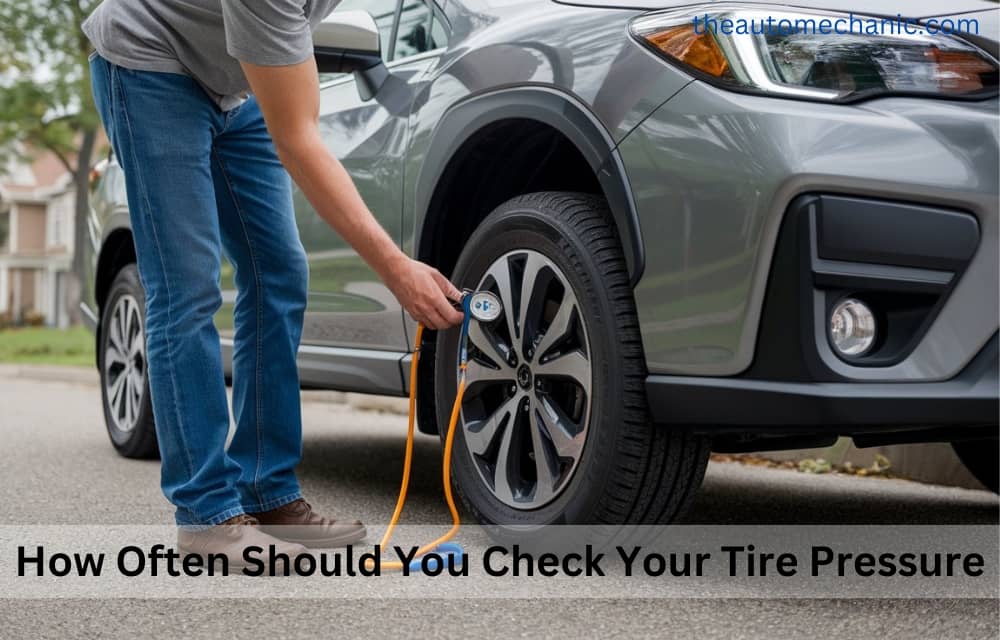Today, we bring you one of the most important articles on “How often should you check your tire pressure?” Tire pressure is the volume of air in a vehicle’s tires. It is one of the key factors contributing to your vehicle’s general safety on the road.
Tires normally lose pressure daily, and different climatic changes factor this in. It is difficult to notice this gradual loss, and when some people notice, they still tend to ignore it.
This puts your life in danger, as well as that of other road users. Therefore, a regular check-up is recommendable. By the end of this article, we will answer the question: How often should you check your tire pressure?
Tires are the only parts of a vehicle that touches the surface. Two essential activities, that is, running and stopping, depend entirely on the tire’s grip on the road surface.
As the tire pressure changes, the shape of the tire changes accordingly. Tires that are too tightly rounded, similar to bicycle tires, will not contact the road surface enough.
On the other hand, with flat tires with slightly concave shapes, the center of the tire will not effectively contact the road. This is the reason why the tires must be inflated with the correct pressure.
What is the Right Tire Pressure for My Car?
Tire pressure capacity varies from one vehicle model to another. In most vehicles, both front and rear tires have different pressure capacities.
You should follow your vehicle’s recommended pressure when filling tire pressure to avoid under-inflation or over-inflation.
A sticker can be found attached to the inside of the driver’s, fuel, or glove box doors. Most vehicles recommend tire pressure between 30 and 40 pounds per square inch (PSI).
If your vehicle’s tires are worn out and you intend to change them, you will continue using the same tire pressure guidelines on your vehicle’s sticker or the manufacturer’s user guide.
This applies where the tires are the same size. Where tires are larger than the stock models of your vehicle, your tire dealer can provide information regarding the appropriate tire pressure.
‘’Avoid inflating your tires to the pressure capacity indicated on the tire surface because that is the maximum capacity of that tire and not the recommended tire pressure’’
Overinflation occurs when car tires are inflated beyond their tire pressure capacity. It is likely to affect vehicle performance and tire wear negatively.
In this situation, the chances of tire blowout are high. You can easily lose control and cause a crash. You will also have a bumpy ride experience. Your vehicle is likely to lose balance on the road.
Over-inflation can also cause the tire to be distorted, reducing traction and increasing wear and tear.
Under-inflation happens when the tire pressure goes below the recommended capacity. This is one of the main causes of tire failure. It has an equal measure of consequences as over-inflation. It brings us to another question, as seen below:
What is the Lowest Tire Pressure You Can Drive On?
The manufacturer recommends having a regular check. However, many drivers ignore this until the tires are too low to be noticed.
Therefore, it is important to note that the lowest tire pressure you can drive is 20PSI (Pounds per Square Inch).
Any tire pressure below this is extremely dangerous. It also puts you at risk of a potentially devastating blowout. Also, driving on under-inflated tires increases friction since too much of the tire touches the road.
In return, this causes the tires to overheat. This can result in tread separation, blowouts, and premature wear. It also affects vehicle handling and reduces fuel efficiency.
Tire Pressure Monitoring System (TPMS)
When the tire pressure reaches 25% and below the manufacturer’s recommended PSI, the low-tire-pressure warning light will illuminate the dashboard.
The technology behind this is called Tire Pressure Monitoring System (TPMS). This is an electronic system designed to monitor your tire pressure.
It uses sensors on the vehicle to determine when a tire has low pressure. Then, it alerts the driver with a warning light so the tires can be checked out.
If your vehicle has reached this point, treat the warning sign with urgency. It is necessary before things get out of hand. The Tire Pressure Monitoring System (TPMS) can be direct or indirect.
Indirect Tire Pressure Monitoring System
An indirect tire pressure monitoring system is mostly used on non-luxury vehicles. It shows the driver a fundamental alert if a tire has lost pressure.
It uses the Anti-lock Brake System (ABS) wheel speed sensors to compare the rolling speed of one tire against the others.
A tire that is low on pressure will rotate at a different number of revolutions per mile compared to the other three, which will inform the vehicle’s onboard computer.
Disadvantages of using Indirect Tire Pressure Monitoring System (TPMS)
Indirect TPMS cannot produce accurate and reliable readings, and it can fail to warn you when all four tires lose pressure simultaneously
They are unable to notice slow leaks. This means the driver will only be informed when all the pressure is lost and the tire is flat. At this point, replacing the tire will be the only option left. Expensive right?
Direct Tire Pressure Monitoring System
It is commonly found in luxury vehicles. In a vehicle with a direct Tire Pressure Monitoring System, tire pressure sensors are fixed on the vehicle’s wheels.
An inside vehicle receiver alerts the driver when the pressure in any tire drops below the recommendable level, usually below 25% of the recommended tire pressure.
The advantage of using Direct TPMS is that it is more reliable and accurate, and most of it can signal the tire is under-inflated.
The disadvantage of using Direct TPMS is that maintaining a tire with a direct tire pressure monitoring system may be a bit expensive compared to indirect TPMS.
This is because the tire pressure monitoring system sensors and the direct tire pressure monitoring system may require more testing and labor to maintain in good condition.
However, if you are not keen enough, you may fail to identify your dashboard’s low tire warning light for direct and indirect TPMS.
This is evidence that a high number of drivers are likely to be on the roads unaware of a potentially serious safety issue.
Therefore, the only sure way to maintain optimum tire pressure in your vehicle is to check it more often.
The Tire Pressure Monitoring System (TPMS) may also malfunction. If the light comes on and all your tires are within the recommended tire pressure range, you may have a malfunctioning TPMS.
You can book an appointment with your mechanic to fix it to avoid further damage to your vehicle.
‘’Tire pressure can be lost without a tire appearing to be under-inflated or flat. Therefore, simply because a tire seems to be ok, it doesn’t necessarily mean it is ok’’
What are the Causes of Low Tire Pressure?
Having known the recommendable tire pressure for your vehicle and having understood the lowest tire pressure you can drive on, you can now comfortably check the tire pressure for your vehicle.
You can only understand this question if you know what the lowest tire pressure you can drive on is. Here are some of the causes of low tire pressure.
Tire damage—This may be caused by an invisible crack or hole in the tires or by general wear and tear. The best solution is tire replacement.
Change in Temperature – Tire pressure fluctuates with the outside temperature. This is not necessarily a problem but a rule of nature.
According to the rule of thumb, tires generally lose a pound of pressure for every 10°F decrease in temperature. This is common for most passenger vehicles. Tires are likely to deflate during cold seasons and over-inflate during hot seasons.
Normal Tire Pressure Loss – Normally, the tire loses at least a pound of pressure monthly.
”You don’t have to wait until your tires are flat. Fixing your tire pressure is cheaper than replacing the tire”
How Often Should You Check Your Tire Pressure?
Tire pressure check-ups should be conducted regularly, like once per month. It should be done when the tires are cold, that is, early in the morning or after the car has stopped for some hours.
This is because when your tires are in constant motion, friction generates heat, increasing both air pressure and temperature.
Your tire pressure can be checked by your professional mechanic, your favorite auto-part store, or gas stations, or you can also do it yourself.
If you conduct the tire pressure check-up, you will require a tire pressure gauge and an air compressor.
Follow the following steps for a successful tire pressure check-up and how you can fix over-inflation or under-inflation:
Step 1:
Ensure your vehicle has rested enough to avoid the heat from the friction of the last drive.
Step 2:
Open the valve cap. Press the tire gauge onto the valve system hard enough until the hissing sound disappears.
Your readings should have been displayed now, as long as the pressure gauge is properly connected. Note down the readings and repeat the process on other tires. This is because different tires may have different pressure capacities.
Step 3:
Compare the readings of all the tires with the recommended tire pressure of your vehicle.
Step 4:
If you find a tire that is underinflated, use the air compressor to fill it to the recommended tire pressure.
If you happen to fill your tires when they are hot, fill them 3-4 PSI above the recommendable PSI and check again using your gauge when they are cold.
Step 5:
If you find that you have over-inflated, press the gauge harder on the valve system to release pressure until you achieve the correct readings.
”You don’t have to wait until your tires are flat. Fixing your tire pressure is cheaper than replacing the tire”
The Impacts of Tire Pressure on Vehicle Performance
Maintaining your tire pressure at optimum increases your tire’s lifespan. Just a loss of 1 pound per square inch (psi) of tire pressure can decrease the life cycle of your tires by 25%.
Just a slight under-inflation on your tires can add your fuel economy up to 5% and more.
Underinflated tires increase the stopping distance at normal speeds by more than 8 meters. This is even more severe during wet and windy weather conditions. The speed tends to increase even more when the vehicles are heavily loaded.
Under-inflation is also a leading cause of tire failure. This is due to the friction created when more of the tire’s surface touches the road. This friction can cause extreme blowouts, tread separation, overheating, and premature wear.
The center tread on overinflated tires tends to wear out faster. The fragile qualities of an overinflated tire minimize the chances of safe cornering. Since the tire is more rigid and stiffer, it is more likely to suffer damage from striking curbs or potholes.
Over-inflation also decreases tire lifecycle. In the long run, excessive wear and tear will cost you more.
Conclusion
Now that you know the lowest tire pressure, you can drive on it. But how often should you check your tire pressure?
As answered, you are in a better position to maintain your tire pressure at optimum levels. Therefore, it is recommended that you check your tire pressure regularly, especially before a heavy load or a long drive.
Ensure that your vehicle is properly inflated to save on unnecessary maintenance costs and enjoy full vehicle performance. This will also protect you, your vehicle, and other road users.

Bruce William is a professional content writer and vehicle engineer with extensive car maintenance and repair knowledge. His expertise spans all vehicle parts, offering practical solutions for various automotive issues. Bruce provides valuable insights through his website articles to help readers maintain their cars for optimal performance and longevity.

